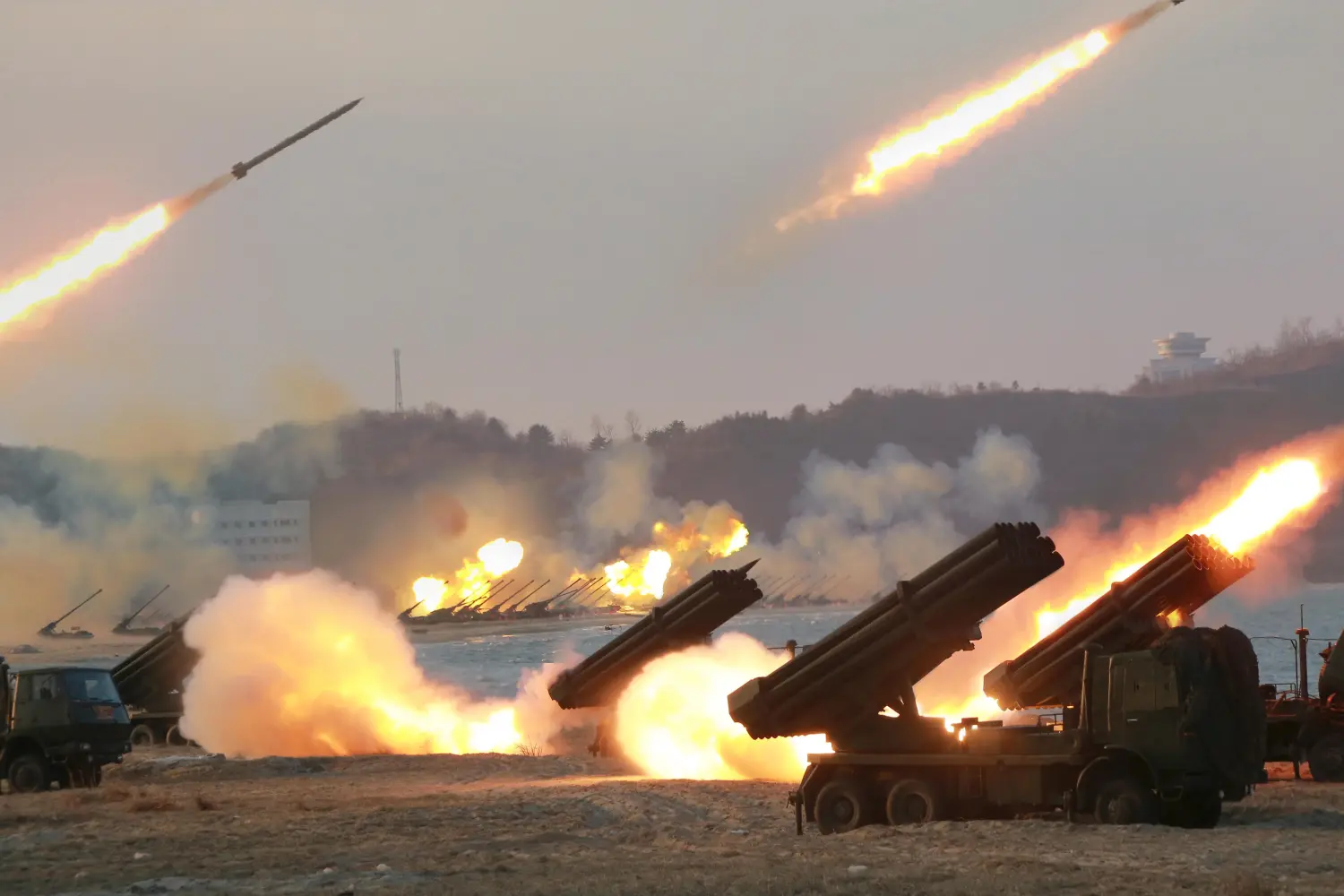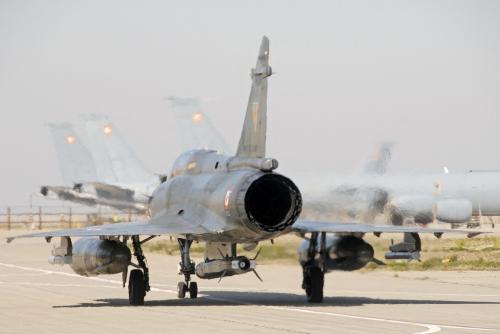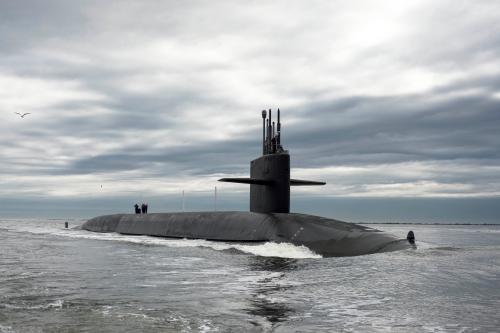This report is part of “A Blueprint for the Future of AI,” a series from the Brookings Institution that analyzes the new challenges and potential policy solutions introduced by artificial intelligence and other emerging technologies.
To illustrate how artificial intelligence (AI) could affect the future battlefield, consider the following scenario based on a future book I am writing entitled The Senkaku Paradox: Risking Great Power War over Limited Stakes. The scenario, imagined to occur sometime between now and 2040, begins with a hypothesized Russian “green men” attack against a small farming village in eastern Estonia or Latvia. Russia’s presumed motive would be to sow discord and dissent within NATO, weakening the alliance. Estonia and Latvia are NATO member states, and thus the United States is sworn to defend them. But in the event of such a Russian aggression, a huge, direct NATO response may or may not be wise. Furthermore, the robotics and AI dimension of this scenario, and a number of others similar to it, will likely get more interesting as the years go by.
A hypothetical scenario in which Russia creates a pretext to slice off a piece of an eastern Baltic state, occupying it in purported “defense” of native Russian speakers there, could cause enormous problems if NATO chose to reverse the aggression. In that event, it could require a massive deployment of Operation Desert Storm-like proportions to liberate the territory while facing down any Russian reinforcements that might be sent. In a less successful case, Russia could interdict major elements of that attempted NATO deployment through some combination of cyberattacks, high-altitude nuclear bursts causing electromagnetic pulse, targeted missile or aerial strikes on ports and major ships, and perhaps even an “escalate to de-escalate” series of carefully chosen nuclear detonations against very specific targets on land or sea.1 While the latter concept of nuclear preemption is not formally part of Russian military doctrine, it could influence actual Russian military options today.2 Alternatively, the NATO deployment could succeed, only to face subsequent Russian nuclear strikes once evidence of NATO’s conventional superiority on the Baltic battlefields had presented Moscow with the Hobson’s choice of either escalating or losing.3
By 2040, some aspects of this kind of scenario could improve for American and NATO interests. The clarity and perhaps the scale of NATO’s security commitments to the Baltic states might have strengthened, reducing the chances of deterrence failure in the first place and improving the initial capacity for resistance to any Russian aggression.4 But on balance, technological innovation, including advancements in robotics and AI, makes it quite possible that things could also get worse.
To be sure, missile defenses will improve. But so will the missiles they have to counter, in terms of their speed and ability to maneuver warheads, along with the use of multispectral sensors or seekers.
Most aspects of the nuclear situation are unlikely to change. Missile defenses may improve, and may include lasers for point defense in some places. These laser defenses could help protect ships or ports or airfields against various types of attack. But because such laser weapons inevitably fall off rapidly in power (as the square of the distance between the weapon and its target), it will be challenging for missile defenses to provide area protection. Thus, while it is at least conceivable that ports and airfields could become much better protected, it is hard to escape the prediction that rail lines, road networks involving large numbers of bridges, tunnels, or elevated routes, and large concentrations of supplies in depots or warehouses will be at least as vulnerable in 2040 as they are today. To be sure, missile defenses will improve. But so will the missiles they have to counter, in terms of their speed and ability to maneuver warheads, along with the use of multispectral sensors or seekers.
Satellites in space are likely to remain highly vulnerable to nuclear attack. That is especially true of satellites in low Earth orbit (LEO), as they are located at altitudes similar to those traversed by ballistic missiles on typical flight trajectories, so they can be attacked by ballistic missile defense technologies. Such objects are also vulnerable, over a period of months, to the residual effects of nuclear detonations in the Van Allen belts—areas of the Earth’s magnetic field where protons and electrons generated by nuclear explosions can “get stuck,” damaging satellites on each orbital pass. Shielding can, in theory, protect against more distant explosions and against such radiation-pumped Van Allen belts, at a typical cost of perhaps 10 percent of the overall satellite. However, it is unlikely that most commercial satellites will be shielded unless the government subsidizes such endeavors. Even with shielding, advanced imaging satellites and other high-value assets in LEO will remain vulnerable since they may be individually and directly attacked by an adversary.5
By 2040, many cyber systems controlling NATO weaponry and other platforms should be more resilient to attack. That is because NATO will have had two decades to address problems that are now widely understood. That is unlike the case 20 years ago, when, even though the Y2K debacle and other scares should have sobered people to the risks of inadequate computer security measures, a general sense of complacency about great-power relations discouraged meaningful action against threats to electronics from hacking, high-altitude nuclear bursts, malicious supply-chain actors who might compromise the integrity of semiconductor chips, and so on. Admittedly, this conclusion assumes greater vigilance on the part of NATO states than will perhaps prove to be the case. However, progress in this arena will probably not be uniform. It seems relatively unlikely to result in meaningful hardening of the critical civilian infrastructure on which militaries depend.
Even if classic computer hacking, spoofing, advanced persistent threats, and related measures gradually lose some of their effectiveness, a new set of challenges is appearing on the horizon. One challenge could be a more efficient form of advanced persistent threat in which efforts to penetrate an adversary’s computer systems employ automated capabilities with massive raw computational power that continually adjust tactics to the defenses encountered.
Even if classic computer hacking, spoofing, advanced persistent threats, and related measures gradually lose some of their effectiveness, a new set of challenges is appearing on the horizon.
Another major complicating development could be the advent of constellations or swarms of smart robotic devices. For example, by 2040, large numbers of smart sea mines could pose enormous threats to shipping; in the scenario of Russian aggression, NATO would need to mount a response to these threats.6 The devices might in effect be miniature submarines, with sensors and explosives as payload. Russia is already strong in submarine technology7 and could probably master this type of technology in the years to come. Such unmanned underwater vehicles (UUVs) could be widely deployed in places like the Baltic Sea in times of crisis. Rather than having to hunt for a couple dozen Russian submarines, as might be the case today—already a daunting proposition—NATO forces seeking to reach Baltic ports might need to search for hundreds or even thousands of potent threats. It seems implausible that arms control agreements would prevent the development and deployment of such autonomous systems, not only because of the verification challenges but also because the United States itself will feel powerful incentives to create more autonomous systems, including those with the ability to employ lethal force under certain types of conditions, as Paul Scharre has convincingly argued.8
In another scenario, swarms of quadcopters (unmanned helicopters with four rotors), each packing several kilograms of explosives—thus able to destroy a modern jet if detonated at the right location—might attack NATO air bases and the aircraft on them. Terminal defenses using lasers could possibly destroy some of the incoming threat devices or weapons, but the swarm could then choose a different attack route or seek to overwhelm a defense with a saturation attack. Swarms could also deploy in the airspace surrounding an airfield, staying out of range of any such directed-energy defenses and attempting to strike aircraft as they left or approached a runway.
There are some situations that pose particular challenges. Imagine loitering aerial devices akin to the sensor fuzed weapon (SFW) that have been part of the U.S. armamentarium for years. This weapon is somewhat controversial: it is categorized as a “cluster munition,” a type of weapon banned by international convention, though the United States is not a party to the accord.9 However, it is better thought of as a type of robotic weapon. The benefit of such technologies in combat was discussed extensively as far back as 1998, when a RAND study envisioned their use in situations such as an Iraqi armored vehicle attack against Saudi Arabia on major highways. In that model, which considered technologies available at the time, some 10,000 weapons carrying 40 Skeet submunitions, or perhaps the Brilliant Anti-Tank (BAT) weapon, would suffice to destroy several thousand armored vehicles and effectively halt an enemy assault. The total cost of the ordnance was estimated at several billion dollars.10 Such munitions could be used in a similar way against NATO movements on major roads in Europe, advancing from western points toward Poland and the Baltic states, with the munitions delivered in the future by small robotic devices. Swarms of robotic devices carrying munitions payloads could also be used to attack trains or road convoys in transit, perhaps after being positioned by special forces that had penetrated into NATO territory.
Another type of robotic swarm might be used to create an interconnected network of unmanned aquatic systems functioning, in effect, as mobile mines or torpedoes. This is not presently a technology concept that the U.S. Navy has come close to operationalizing; a 2013 RAND study lists the technology maturity of such systems as between 1 and 3 on a Technology Readiness Level scale that goes from 1 to 9.11 However, the constituent technologies, such as automated sensors, are already largely available.12 As AI improves, a constellation of such devices could be made largely autonomous.
Much of the relevant technology is already available. Drug-trafficking organizations have been using semisubmersibles to transport drugs to the United States for years, now craft with very slender vessel designs that are efficient at cutting through waves (though still slower than most warships).13 A decade ago, it was already possible to build such boats with a payload of 10 tons and at a cost of less than $1 million per vessel; they were often manned then, but making them fully autonomous would not be a major leap.14
Clearing operations against what would in effect be mobile and self-healing minefields populated by devices that can communicate with each other and reposition themselves to create dense, lethal networks will be much more difficult than clearing current threats.
Such capabilities create the specter of not just “smart mines” (able to distinguish one type of ship from another before detonating) but mobile, re-deployable, and agile mines operating as autonomous networks. Since mines have been responsible for most U.S. Navy ship losses since World War II, this is a particularly unsettling prospect.15 In modern times, the U.S. Navy has primarily avoided mines by staying clear of waters where they might be deployed, as opposed to having any particularly effective counter to them. The main alternative, as outlined by Caitlin Talmadge, would be to conduct extensive clearing operations to create relatively narrow channels for movement, if enough time is available for such purposes. (Talmadge estimated a month or more in a scenario in which Iran mined the Persian Gulf and the U.S. Navy and allies then sought to clear the waterways.)16 Used against America’s enemies of recent decades, this might have been a doable proposition. But when a U.S. Navy vessel has to approach a Baltic port against a Russian foe of 2025 or 2030 or 2035 or 2040, the situation could be very different. Clearing operations against what would in effect be mobile and self-healing minefields populated by devices that can communicate with each other and reposition themselves to create dense, lethal networks will be much more difficult than clearing current threats.
If NATO figured out how to jam the communications between smart, unmanned, mobile mines, the adversary’s robotic systems might simply be deployed in redundant patterns to be sure there were no gaps in coverage. They could also be programmed to change their positions every so often to elude neutralization and to repair any potential gaps in their coverage—even if there were no central data processor that actually knew where the gaps were located and even if space-based navigation systems were disabled (since the UUVs could have various types of inertial or bottom-following guidance).17 The network could be set up simply to play the odds, in an environment of little communication and poor information exchange.
How many such UUVs might be needed to achieve the desired effect of rendering transport ships highly vulnerable as they approached a port such as Talinn or Riga? As one possibility, the devices might be released from Kaliningrad with instructions to move eastward toward the littoral waters of those port cities. Even existing battery technology makes a “swim” of such distance within reach.18 Progress in nanomaterials and other constituent elements of batteries may further improve performance in the years ahead.
One way to estimate the quantitative requirements for such a UUV network is to compute how long a picket line might be needed near those ports to cover all possible lines of approach, and then estimate the needed density of separate armed devices along that line. Whatever estimate followed from this simple calculation might then be multiplied by two or three or four to account for attrition of some devices as a result of NATO anti-mining efforts or malfunction.
The approach to Riga, Latvia, is through a body of water about 40 miles wide at points near the port. The picket line might be set up roughly three-to-five miles offshore, where water depths are 100 feet or more—making it hard to detect any submersible object visually.19 The math might go something like this:
- If the range of each UUV’s lethal mechanism is similar to that of a modern torpedo such as the U.S. Mark 48, then they might be spaced every one-to-five miles—based on the fact that these torpedoes can typically lock on to targets from a distance of 4,000 yards.20
- To improve the density of the picket line and allow multiple shots to be taken at a given transport, the spacing might be kept at perhaps one mile, meaning that 40 UUVs would be needed to populate a given picket line.
- With multiple picket lines, perhaps 200-to-500 UUVs in all, at a cost of no more than several hundred million dollars, it would be very difficult to approach the wharves at Riga.
Of course, the United States and other NATO countries could attempt to thwart the operations of these UUVs. They could try to destroy them en masse at their source before the UUVs could be released. They could also create their own robotic swarms designed to find, identify, and neutralize the attacking weapons.
But there would be a fundamental difference from today’s situation. The kind of impunity that U.S. forces have enjoyed for decades during intercontinental movement would be threatened to some degree and could no longer be assumed. And even Russia’s relatively modest military resources would still be ample for the kinds of investments needed in these domains, in purely financial terms, as the above calculations underscore.
If necessary, NATO could avoid some of these problems by staying out of the Baltic Sea. U.S., Canadian, and U.K. forces could deploy to France or the Netherlands or Germany and then move eastward toward Russia, picking up allied help along the way. This strategy might eventually work—but with considerable time delays and with vulnerabilities during movement along road and rail networks. Moreover, Russia might doubt that NATO would have the will to mount such a response. Thus, the key goal of upholding deterrence might be lost, even if, in theory, a war could eventually be won.
Robotics and AI could take on a central, and very important, role in warfare by 2040—even without anything resembling a terminator or a large killer robot.
Because of NATO’s strategic depth and its enormous resource disparity when measured against Russia’s—two advantages the United States and its Pacific allies would likely not have in the Pacific theater against China—NATO would still be favored to win a conventional-only conflict in eastern Europe 20 years from now. But the degree of difficulty would be quite considerable and the degree of escalatory risk highly unsettling. In my book, I attempt to offer Washington and other NATO capitals some policy options. For the purposes of this essay, the simple point is this: robotics and AI could take on a central, and very important, role in warfare by 2040—even without anything resembling a terminator or a large killer robot.
-
Footnotes
- See, for example, Fabrice Pothier, “An Area-Access Strategy for NATO,” Survival 59, no. 3 (June–July 2017), pp. 73–79.
- Alexander Velez-Green, “Russian Strategists Debate Preemption as Defense against NATO Surprise Attack” (Washington: Center for a New American Security, March 2018).
- In their discussion of the new U.S. Army and Air Force concept of Multi-Domain Battle, General David Perkins and General James Holmes convincingly argue that an enemy will contest U.S. and allied operations across many different realms simultaneously. See General David G. Perkins and General James M. Holmes, “Multi-Domain Battle: Converging Concepts toward a Joint Solution,” Joint Forces Quarterly 88 (1st quarter, 2018).
- Paul B. Stares, Preventive Engagement: How America Can Avoid War, Stay Strong, and Keep the Peace (Columbia University Press, 2018), pp. 154–55.
- Barry D. Watts, The Military Uses of Space: A Diagnostic Assessment (Washington: Center for Strategic and Budgetary Assessments, 2001), p. 99; Peter L. Hays, United States Military Space: Into the Twenty-First Century (Montgomery, Ala.: Air University Press, 2002), pp. 121–24; Michael E. O’Hanlon, Neither Star Wars Nor Sanctuary: Constraining the Military Uses of Space (Brookings, 2004), pp. 67–70, 126–27; and Bruce G. Blair, Strategic Command and Control: Redefining the Nuclear Threat (Brookings, 1985), pp. 201–07.
- Such mines could be developed in fairly short order today; see Ochmanek and others, U.S. Military Capabilities and Forces for a Dangerous World, pp. 16–19, 28.
- Dave Majumdar, “The Rise of Russia’s Military,” National Interest 156 (July/August 2018), pp. 36–46.
- Paul Scharre, Army of None: Autonomous Weapons and the Future of War (New York: W. W. Norton, 2018).
- Thomas Gibbons-Neff, “Why the Last U.S. Company Making Cluster Bombs Won’t Produce Them Anymore,” Washington Post, September 2, 2016.
- David A. Ochmanek and others, To Find, and Not to Yield: How Advances in Information and Firepower Can Transform Theater Warfare (Santa Monica, Calif.: RAND, 1998), pp. 1–40, 83–100.
- See, for example, Scott Savitz and others, U.S. Navy Employment Options for Unmanned Surface Vehicles (USVs) (Santa Monica, Calif.: RAND, 2013), pp. 7, 18, 33.
- Robert W. Button and others, A Survey of Missions for Unmanned Undersea Vehicles (Santa Monica, Calif.: RAND, 2009), p. 57.
- Kyle Mizokami, “Colombian Drug Smugglers Built This Stealthy, Special Forces–Inspired Boat,” Popular Mechanics, June 13, 2017.
- David Kushner, “Drug-Sub Culture,” New York Times Magazine, April 23, 2009
- Captain Wayne P. Hughes Jr. (ret.), Fleet Tactics and Coastal Combat, 2nd ed. (Annapolis, Md.: Naval Institute Press, 2000), p. 153.
- Caitlin Talmadge, “Closing Time: Assessing the Iranian Threat to the Strait of Hormuz,” International Security 33, no. 1 (Summer 2008), pp. 82–117. An alternative analysis argued that one month might be an exaggeration, for simple mine technology, but my main concern here is with more advanced mines. See William D. O’Neil, “Correspondence: Costs and Difficulties of Blocking the Strait of Hormuz,” International Security 33, no. 3 (Winter 2008–09), pp. 190–95.
- Button and others, A Survey of Missions for Unmanned Undersea Vehicles, pp. 51–52.
- Ibid., pp. 21, 63.
- See “Approaches to Port of Riga,” GPS Nautical Charts, Bist LLC, 2014 (http://fishing-app.gpsnauticalcharts.com/i-boating-fishing-web-app/fishing-marine-charts-navigation.html#9/57.0200/24.0100).
- Kyle Mizokami, “The U.S. Navy Is Getting a More Lethal Torpedo,” Popular Mechanics, December 27, 2016.
The Brookings Institution is committed to quality, independence, and impact.
We are supported by a diverse array of funders. In line with our values and policies, each Brookings publication represents the sole views of its author(s).








